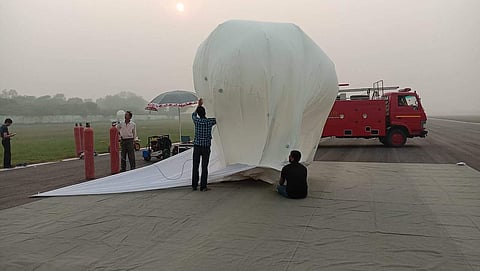

As the entire country waits with baited breath for the epochal verdict by the Supreme Court on the controversial Ayodhya case, this Indian Institute of Technology Kanpur (IIT-K) team developed an 'aerostat balloon' that will be deployed for aerial surveillance of the site. A team of researchers led by Subrahmanyam Saderla, Assistant Professor, Department of Aerospace Engineering at IIT-K has created the aerial vehicle so that the activities happening in the area can be monitored and recorded.
Assistant Professor Subrahmanyam said that the balloon's exclusive feature is that it can rotate in any direction and has a camera which can record even the minutest of occurrences. "The aim of the aerostat balloon is to provide static surveillance for a longer time from a certain altitude. Drones can last only 40 minutes and there are certain restrictions to use them in the public places like in crowded cities and areas. This particular system will not have any moving component and it works on the principle of bouyancy and the winds that are blowing in the area at a given time," he adds.
Explaining why the balloon is more viable, he says, "How it differs from the actual advertisement balloons is they are never a stable system, whenever there's any kind of disturbance it will fall down and again go up. It is generally hoisted with the help of four to five cables, even then the balloon is not stable sometimes. When there is no wind, the aerostat can stand vertically at the point of deployment. It is designed in a way that it will stay in place," he explains.
The balloon's USP lies in several factors ranging from how it is controlled to what it comprises of. "We also have live tether that will communicate to the onboard payload. The current design is about 33 cubic metres and it can carry a payload (carrying capacity of an aircraft or launch vehicle) of 10 kilograms. The balloon will be tethered to the ground station by means of a ground cable near the control room and the altitude can be controlled by releasing this tether. To control the onboard payload we are using a remote similar to the ones that you use for unmanned aerial vehicles. It also has a camera equipped with night vision, 360 degree rotating option, and a 20x optical zoom capability. From the point of deployment it can cover a radius of about three kilometres. Once we fill gas in the balloon it can last for at least a span of two to three days depending upon atmospheric conditions," says Subrahmanyam.
The Uttar Pradesh Police are already using drone cameras to monitor activities in the holy city ahead of the Supreme Court verdict in the Ram Janmabhoomi-Babri Masjid title dispute case. The balloon will be deployed soon and it will be used for surveillance as long as the authorities permit.
